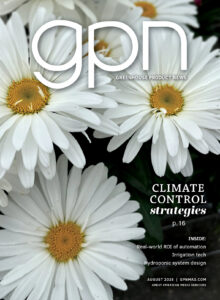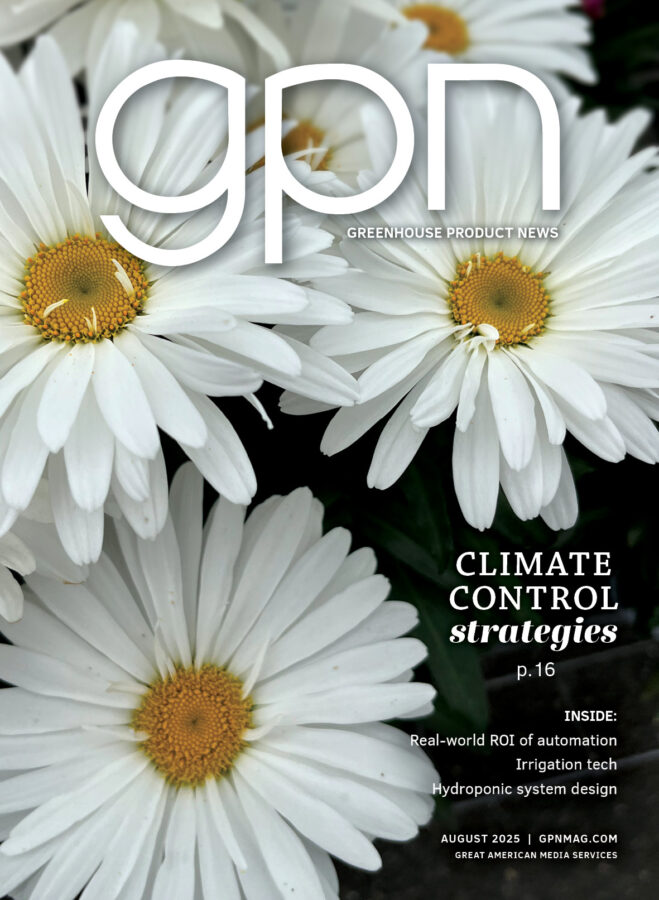Harvesting Peat
In the 1960s, professors at Cornell University were among the first to advocate the use of peat in their soilless Peat-Lite mixes for greenhouse production. Several properties of peat moss have led to its widespread adoption by the industry over the intervening decades; these include : high water holding and cation exchange capacity, lack of residual herbicides and weed seeds compared to soil and composts, and low incidence of root-borne pathogens.
Recently peat has received attention in terms of its place in sustainable plant production. While many other organic-based components such as coconut coir, rice hulls and compost are available for soil-less substrates, peat remains the number one component (by volume) in U.S. greenhouse potting mixes. We recently had an opportunity to visit peat bogs in Quebec, Canada, where several companies harvest sphagnum peat (Figure 1). We wanted to learn how peat is harvested and packaged, why these processes are followed, and how they impact the product you receive.
Harvesting and Processing
When a company wants to open a new peat bog for harvesting, surveys are conducted to determine if a site contains horticulture grade sphagnum. The peat should have a depth of at least 2 meters, as it is desirable that a bog be able to be harvested for many years (Figure 2). Ditches are built to drain surface water and access roads are built to allow heavy equipment to operate.
Harvest takes place when bogs are not frozen, usually May through September. Milling machines are used to loosen only the top inch or two of peat; this keeps the underlying bog intact so it is not able to erode away.
The top layer is allowed to dry in the sun for a few days. Abnormally rainy conditions delay the ability to harvest from a given site. Contrary to what some believe, peat is no longer cut into large bricks for harvest. Instead, peat is collected from fields very carefully using vacuum harvesters, which collect fibers from about a 1/4-inch top layer (Figure 3). The use of vacuum harvesters reduces physical disturbance to the peat. The goal during the entire harvesting and processing process is to preserve the integrity of peat fibers. Mechanical damage can break apart sphagnum fibers, which decreases its porosity in a container and can create more dust. Several passes can be made over the same field during the year. In total, about a 2- to 3-inch layer of peat may be mined for a site in one year. A given peat bog is harvested for many years. For example, we viewed a peat bog that has been harvested continuously since 1929.
Processing and Packaging
Vacuum harvesters empty their peat into large piles at the edge of the bog (Figure 4). Large truck-drawn hoppers carry the vacuum-harvested peat to the nearby processing facilities. The collected peat is screened to remove impurities such as wood, roots or large clumps of peat (Figure 5).
Depending on the peat's purpose, it is then packaged "as is" or it is blended with other materials to create soil-less potting mixes. Several components are added to peat to develop potting mixes. Wetting agents are added as dry peat repels water and is hard to moisten initially. Limestone is added to raise the pH of peat to about 6.0, which is perfect for root growth and nutrient availability. Aggregates such as perlite or vermiculite are added to increase air porosity.
Finally, a starter nutrient charge may be added for initial plant growth. Peat from different sources may be combined together at this stage — for example, the upper layers of bogs often yield fluffy fibers with very good air porosity, while older layers may yield more highly decomposed peat which has a greater cation exchange capacity (improved nutrient retention) and better disease suppressive properties.
Peat and peat-based potting mixes are either packaged loose or compressed. Loose peat is easier to use directly in a pot, but is less efficient to ship. Compressed bales allow the same amount of peat to be packaged in a smaller volume, which helps reduce shipping costs. While compressed bales are sold based on the volume in the bag, once the peat is fluffed and used, it will typically yield two to three times that volume. At the facility we were visiting, quality control personnel were checking 3.8 cubic foot compressed bales to ensure that once they were fluffed they yielded at least 9 cubic feet of peat moss.
Increasingly, greenhouse operations are purchasing large pallet-sized peat bales. The large bale is loaded into a bale buster, which fluffs the peat as it shaves down the bale. These large bales are beneficial as they reduce the labor associated with opening many small plastic bales. The large bales also provide significant savings of plastic.
Lessons from the Bog
In the end, the trip to several peat bogs and packing facilities led to some insights.
Not all peat is the same. Locations differ based on the sphagnum species growing in the bog as well as the depth of the peat layers being harvested. Substrate suppliers often sell peat from several locations intended for different purposes. Properties that can differ include : fiber length/texture that affects drainage, cation exchange capacity, and microbe fauna, which can sometimes offer disease suppressive properties.
Very little material from a peat bog is wasted. The top layer of sphagnum (un-decomposed) is sold for specialty horticulture uses, such as lining hanging baskets or in orchid mixes. The next layers contain higher quality and less decomposed peat fibers that allow for better drainage in the container. These layers may be used in aggregate free mixes or in mixes with a lower percentage of perlite. Finer grade peat material is used in our propagation mixes, consumer garden products, and is also ideal for use by the mushroom industry. Clumps of peat, selected out in the screening process, can be used for animal bedding or added into aggregate free mixes. Even the wood materials screened out before processing can be composted.
Following the productive life of a given bog, Canadian law requires harvested peat lands be returned to sphagnum bog, reclaimed as wildlife or forest land, or turned into land for agricultural production Ð typically acid-loving plants such as blueberries or cranberries (Figure 6).









 Video Library
Video Library 


















